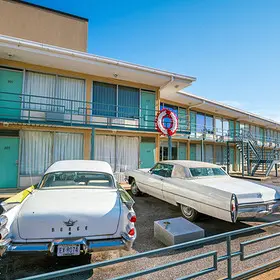9 Historic Civil Rights Sites: Commemorating the March On Washington
Historic sites that represent the fight for equality in America are essential to telling the full story of this important chapter of our nation's history. To commemorate the anniversary of the March On Washington for Jobs and Freedom, we're highlighting nine sites across the country that preserve the memory of the struggle for civil rights.
Paul Robeson House—Philadelphia
The Paul Robeson House in West Philadelphia is the last home of Paul Robeson, the legendary African American scholar, athlete, actor, singer, and human rights activist. Robeson was renowned for his rich baritone voice, superb acting, and passionate zeal for racial justice. Today, the Robeson House produces, presents, and promotes traveling lectures, concerts, and exhibits. The Pennsylvania Historical Museum Commission and the White House officially recognized the museum as a national historic preservation site. The West Philadelphia Cultural Alliance completed a restoration of the home in 2015, although some parts of the project still require work.

photo by: Ekem/Wikimedia Commons
The Paul Robeson House in West Philadelphia.
Daisy Bates House—Little Rock, Arkansas
Daisy Bates was the principal organizer of the group of African American students known as the Little Rock Nine. These children are famous for integrating Central High School in Little Rock, Arkansas. Bates’ home became the headquarters for the battle to integrate Central High School and a haven for the nine students. Bates soon became a nationally recognized advocate for civil rights due to her perseverance to desegregate public schools. The house today is a National Historic Landmark.
photo by: Daisy Bates House/Wikimedia Commons
Daisy Bates House, Little Rock, Arkansas.
The Rosa Parks Bus—Dearborn, Michigan
On December 1, 1955, Rosa Parks’ courageous action to not give up her seat to a white man started the Montgomery Bus Boycott, a calculated act which in turn sparked the modern American civil rights movement. Decades later, that same bus was found lying unprotected and deteriorating in a field. In 2002, the Henry Ford Museum in Dearborn, Michigan, restored this iconic piece of history and returned it to its 1955 physical appearance, now shown as a permanent exhibit. Today, the restored bus tells one of America's greatest stories about one of our most revered heroes.
Lorraine Motel—Memphis, Tennessee
On April 4, 1968, Dr. Martin Luther King Jr. was assassinated on the balcony of his room at the Lorraine Hotel in Memphis, where he had traveled to support the city’s sanitation workers strike. Built in 1925 as a "Whites Only" motel, by the end of World War II, the Lorraine had become a black establishment that hosted Cab Calloway, Count Basie, and other prominent jazz musicians of the day. It is now home to the National Civil Rights Museum, following a long campaign to save the modest motel from foreclosure or demolition.Malcolm X – Ella Little-Collins House—Boston
Built in 1874, the Malcolm X – Ella Little-Collins House is a modest structure and the last known surviving boyhood home of Malcolm X. He shared the house with his half sister, Ella Little-Collins, whose son is the current owner. Largely vacant for over 30 years, plans are in development to rehabilitate and reuse the deteriorating property. In partnership with Historic Boston, the National Trust for Historic Preservation is working to preserve Malcolm X’s legacy by transforming the house into living quarters for graduate students who are studying African-American history, social justice, or civil rights.
Tell the Full History: Historic Places That Matter to Aldis Hodge and More

Want to learn more about the Lorraine Motel? Aldis Hodge, Phylicia Rashad, Tia Mowry-Hardrict, and Marcus Scribner share stories of the places that matter to them.

photo by: Steve Dunwell
The Malcolm X – Ella Little-Collins house in Boston.
Medgar Evers Home—Jackson, Mississippi
Civil Rights leader Medgar Evers lived with his family in a house at 2332 Margaret Walker Alexander Drive in Jackson, Mississippi. The house was constructed for the Evers family in 1957, and it was in the driveway of this house that on June 12, 1963, Evers was assassinated after returning from an NAACP meeting. The home was designated a National Historic Landmark on May 24, 2018Freedom Rides Museum—Montgomery, Alabama
A Montgomery bus station that could have easily been demolished today stands as an enduring tribute to the bravery of Freedom Riders and their contribution to our nation’s civil rights struggle. The Freedom Rides Museum encompasses the courthouse where former U.S. District Judge Frank M. Johnson Jr. presided over crucial civil rights cases, as well as the modest bus station next door where, in 1961, an integrated group of 21 college students used nonviolent means to protest segregation.
photo by: Chris Pruitt/Wikimedia Commons
Old Montgomery Greyhound Station, Montgomery, Alabama.
F.W. Woolworth Building—Greensboro, North Carolina
The Woolworth's Five & Dime in Greensboro, North Carolina was the scene of a sit-in that began with four college freshmen at the store's "Whites Only" lunch counter and ended with more than 400 protesters. A year later, 126 cities, including Greensboro, had integrated their restaurants and lunch counters. Today the building houses the International Civil Rights Center and Museum and includes the original portion of the lunch counter and stools where the four pioneering students sat.
Emmett Till Historic Sites
Fourteen-year-old Chicago resident Emmett Till was visiting relatives in Money, Mississippi, in the summer of 1955 when he was brutally killed, supposedly for whistling at a white woman who worked at a local market called Bryant’s Grocery. Three sites in the local area help tell the story of Till’s tragic death: Bryant’s Grocery; a local funeral parlor where Till’s body was kept before being transported back to Chicago; and the Tallahatchie Courthouse, where Till’s murderers were found innocent despite overwhelming evidence of their guilt. Bryant’s Grocery is the first stop on the Mississippi Freedom Trail.

photo by: WhisperToMe/Wikimedia Commons
Bryant's Grocery in Money, Mississippi.



